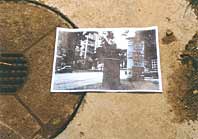
| Intro | The proposal | The leaflet | The mult.trudi events | Outlook | |
Is there a future of exhibition art?




"Where art may take place" Pictures by Yutta Bernhardt, Frankfurt, using material provided by David Goldenberg.
Given: there will still be art exhibitions for a long time in the future from now on.
Yet, the questions as given up by David Goldenberg remain: what are the immanent reasons for exhibition art?
Why is exhibition art a still prevailing model of art practice?
It may be not by chance that another voice from London reaches me these days. That is Clémentine Deliss's writing in her new Metronome (Nr.8: magnetic speech/the bastard) of her understanding of her role as a curator and her view on contemporary exhibition practice:
"I have to make an admission: I am confused about exhibitions. I am nolonger able to believe in them [...] I don't believe in their level of productive uncertainty; it seems way too modest, far too safe. More specifically, I don't believe in their dynamics of transfer. For even those that play down their pedagogical remit still draw the process of interpretation into educational areas that cannot be avoided and no longer negotiated. The understanding of flows of information, channels with access, entries into problematics, the 'about' syndrome, all affect our use of exhibitions as environments that should be fundamentally unstable but, harnessed by these recourses, provide no hazard and offer no gamble. Every time I go to a large show, I sense my own failure at not being able to respond to their language any longer. This sensation goes beyond the occasional moment when a particular art work affects me. [...]
I still refuse to do exhibitions because, in my field of experience, they cannot produce adequate bridging mechanisms between discourses, a prerequisite for translation, for the inter-scenic, for the right to move around in this world and convey ideas through a process of ideomatic exchange. [...] In not doing exhibitions I just want to be more precise about who I am talking to. Which public is my public? Why has exhibitionmaking become so generic?"
Well, this is only one statement. In May 2001 there was a discussion round at the local Portikus adressing the notion of the "white cube".
It is very obvious that the "white cube" is neither about a particular color, nor a specific space, but about a certain practice, a field of habits.
To demonstrate its possible dimensions I posed three questions to the audience:
- How is is possible that curators fill exhibitions year by year with always new and fresh artists, - whereas I myself couldn't find more than three convincing artists in the last ten years. My failure, their success? I mean, is it really convincing that these curators are totally convinced by "their" artists? Do the curators really believe in this number of artists or are the artists only means end?
- I heard that the artist Jenny Holzer has a boyfriend/husband who is a painter. Why is it that they're never together in one show? If there is a dinner party after the show it is very likely that Mr. Holzer is invited there together with is wife, isn't it? What is the difference between an exhibition and a dinner party? In the context of art.
- Since the outbreak of the AIDS crisis several thousand artists may have died from that disease. I don't know how many in Frankfurt. What has been done to the memory of these artists? Are there any monuments, of physical nature or not, reminding of the dead? I'm sure each of them has died with the hope that his/her art might stay on in the hearts, the memories and the works of those living on. I don't know of any efforts here in Frankfurt.
At least my first question got an answer by one of the curators by the local Kunstverein.
She said: "Well, you don't have to like the artists. They just have to fit into the show."
This was blank and straightforward, I think. A wine merchant doesn't have to like all the wines he sells to his customers, right?
But is it decent and correct to talk about human beings like this, like some material?
The scandinavian participants of that discussion round whined about the lack of independent spaces. But are there any independant practices as well?
Stefan Beck
© multi.trudi 2000